BMW X3 (F25) Owners Manual: Safety
Vehicle features and options
This chapter describes all standard, country-specific and optional features offered with the series. It also describes features that are not necessarily available in your car, e. g., due to the selected options or country versions. This also applies to safety-related functions and systems. The respectively applicable country provisions must be observed when using the respective features and systems.
- Airbags
- Tire Pressure Monitor TPM
- FTM Flat Tire Monitor
- Intelligent Safety
- Front-end collision warning with City Braking function
- Front-end collision warning with braking function
- Pedestrian warning with city braking function
- Lane departure warning
- Active Blind Spot Detection
- Brake force display
Airbags
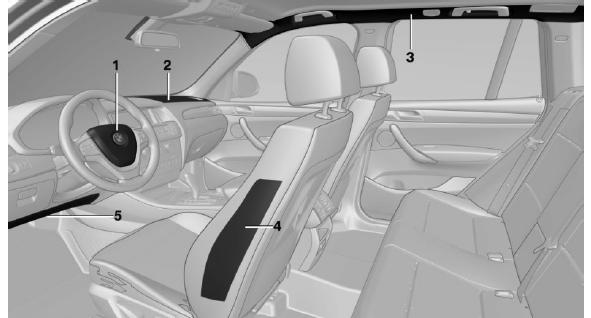
- Front airbag, driver
- Front airbag, front passenger
- Head airbag
- Side airbag
- Knee airbags
Front airbags
Front airbags help protect the driver and front passenger by responding to frontal impacts in which safety belts alone would not provide adequate restraint.
Side airbags
In a lateral impact, the side airbag supports the side of the body in the chest and lap area.
Head airbags
In a lateral impact, the head airbag supports the head.
Knee airbag
The knee airbag supports the legs in a frontal impact.
Protective action
Airbags are not triggered in every impact situation, e.g., in less severe accidents or rear-end collisions.
Information on how to ensure the optimal protective effect of the airbags
- Keep at a distance from the airbags.
- Always grasp the steering wheel on the steering wheel rim, holding your hands at the 3 o'clock and 9 o'clock positions, to keep the risk of injury to your hands or arms as low as possible when the airbag is triggered.
- There should be no person, animals, or objects between an airbag and a person.
- Do not use the cover of the front airbag on the front passenger side as a storage area.
- Dashboard and windshield on the front passenger side must stay clear - do not attach adhesive labels or coverings and do not attach brackets or cables, e. g., for GPS devices or' mobile phones.
- Make sure that the front passenger is sitting correctly, i.e., keeps his or her feet and legs in the footwell; otherwise, leg injuries might occur when front airbag is activated.
- Do not place slip covers, seat cushions or other objects on the front passenger seat that are not approved specifically for seats with integrated side airbags.
- Do not hang pieces of clothing, such as jackets, over the backrests.
- Make sure that occupants keep their heads away from the side airbag and do not rest against the head airbag; otherwise, injuries might occur when airbag is activated.
- Do not remove the airbag system.
- Do not remove the steering wheel.
- Do not apply adhesive materials to the airbag cover panels, do not cover them or modify them in any way.
- Never modify either the individual components
or the wiring in the airbag system.
This also applies to steering wheel covers, the dashboard, the seats, the roof pillars and the sides of the roofliner.
Even when you follow all instructions very closely, injury from contact with the airbags cannot be ruled out in certain situations.
The ignition and inflation noise may lead to short-term and, in most cases, temporary hearing impairment in sensitive individuals.
Malfunction, deactivation and after deploying the airbags
Do not touch the individual components immediately after the system has been triggered; otherwise, you may risk burns.
Only have the airbags checked, repaired or dismantled and the airbag generator scrapped by the service center or an authorized repair shop for handling explosives.
Non-professional attempts to service the system could lead to failure in an emergency or unintentional activation of the airbag - both may lead to injury.
Warnings and information on the airbags are also found on the sun visors.
Functional readiness of the airbag system
 When the ignition is reel on,
the warning
lamp in the instrument cluster lights
up briefly and thereby indicates the operational
readiness of the entire airbag system
and the belt tensioner.
When the ignition is reel on,
the warning
lamp in the instrument cluster lights
up briefly and thereby indicates the operational
readiness of the entire airbag system
and the belt tensioner.
Airbag system malfunctioning
- Warning lamp does not come on when the ignition is turned on.
- The warning lamp lights up continuously.
In case of a malfunction have airbag system checked immediately.
In case of a malfunction have airbag system checked immediately; otherwise, there is a risk that the system does not function as expected in case of a severe accident.
Automatic deactivation of the front-seat passenger airbags
The system reads if the front passenger seat is occupied by measuring the human body's resistance.
Front, knee and side airbag on the front passenger's side are either activated or deactivated.
Leave feet in the footwell
Make sure that the front passenger keeps his or her feet in the footwell; otherwise, proper functioning of the front passenger airbag might not be assured.
Child restraint fixing system in the front passenger seat
Before transporting a child on the front passenger seat, refer to the safety notes and instructions for children on the front passenger seat, see Children.
Malfunction of the automatic deactivation system When transporting older children and adults, the front-seat passenger airbags may be deactivated in certain sitting positions. In this case, the indicator lamp for the front-seat passenger airbags lights up.
In this case, change the sitting position so that the front-seat passenger airbags are activated and the indicator lamp goes out.
If it is not possible to activate the airbags, have the person sit in the rear.
To enable correct recognition of the occupied seat cushion
- Do not attach covers, cushions, ball mats or other items to the front passenger seat unless they are specifically recommended by your vehicle's manufacturer.
- Do not place any electronic devices on the passenger seat if a child restraint system is to be installed on it.
- Do not place objects under the seat that could press against the seat from below.
- No moisture in or on the seat.
Indicator lamp for the front-seat passenger airbags
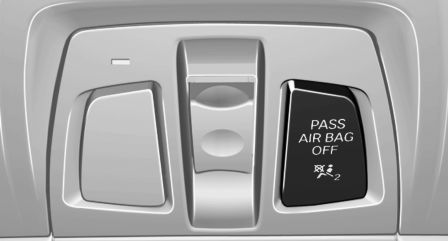
The indicator lamp for the front-seat passenger airbags indicates the operating state of the front-seat passenger airbags.
The lamp indicates whether the airbags are either activated or deactivated.
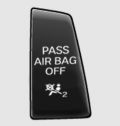
- The indicator lamp lights up when a child is properly seated in a child restraint fixing system or when the seat is empty. The airbags on the front passenger side are not activated.
- The indicator lamp does not light up when, e.g., a correctly seated person of sufficient size is detected on the seat. The airbags on the front passenger side are activated.
Detected child seats The system generally detects children seated in a child seat, particularly in child seats required by NHTSA when the vehicle was manufactured. After installing a child seat, make sure that the indicator lamp for the front-seat passenger airbags lights up. This indicates that the child seat has been detected and the front-seat passenger airbags are not activated.
Strength of the driver's and front-seat passenger airbag
The explosive power that activates driver's/ front passenger's airbags very much depends on the positions of the driver's/front passenger's seat.
With a respective message appearing on Control Display calibrate the front seats to keep the accuracy of this function over the long-term.
Calibrating the front seats
A corresponding message appears on the Control Display.
1. Press the reel and move the respective seat all the way forward.
2. Press the reel forward again. The seat still moves forward slightly.
3. Readjust the seat to the desired position.
The calibration procedure is completed when the message on the Control Display disappears.
If the message continues to be displayed, repeat the calibration.
If the message does not disappear after a repeat calibration, have the system checked as soon as possible.
Unobstructed area of movement
Ensure that the area of movement of the seats is unobstructed to avoid personal injury or damage to objects.
Tire Pressure Monitor TPM
The concept
The system monitors tire inflation pressure in the four mounted tires. The system warns you if there is a significant loss of pressure in one or more tires. For this purpose, sensors in the tire valves measure the tire inflation pressure and tire temperature.
Hints
Tire damage due to external factors
Sudden tire damage caused by external circumstances cannot be recognized in advance.
With use of the system observe further information found under Tire inflation pressure.
Functional requirements
The system must have been reset with the correct tire inflation pressure; otherwise, reliable signaling of tire inflation pressure loss is not assured.
Reset the system after each adjustment of the tire inflation pressure and after every tire or wheel change.
Always use wheels with TPM electronics to ensure that the system will operate properly.
Status display
The current status of the Tire Pressure Monitor TPM can be displayed on the Control Display, e.g., whether or not the TPM is active.
1. "Vehicle info"
2. "Vehicle status"
3.  "Tire Pressure Monitor (TPM)"
"Tire Pressure Monitor (TPM)"
The status is displayed.
Status control display
Tire and system status are indicated by the color of the wheels and a text message on the Control Display.
All wheels green System is active and will issue a warning relative to the tire inflation pressures stored during the last reset.
One wheel is yellow A flat tire or major drop in inflation pressure in the indicated tire.
All wheels are yellow A flat tire or major drop in inflation pressure in several tires.
Wheels, gray The system cannot detect a flat tire due to a malfunction.
Carry out reset
Reset the system after each adjustment of the tire inflation pressure and after every tire or wheel change.
On the Control Display and on the vehicle:
1. "Vehicle info"
2. "Vehicle status"
3.  "Perform reset"
"Perform reset"
4. Start the engine - do not drive off.
5. Reset tire inflation pressure: "Perform reset".
6. Drive away.
The tires are shown in gray and the status is displayed.
After driving faster than 19 mph/30 km/h for a short period, the set tire inflation pressures are accepted as reference values. The reset is completed automatically while driving.
The progress of the reset is displayed.
After a successfully completed Reset, the wheels on the Control Display are shown in green and "Tire Pressure Monitor (TPM) active" is displayed.
You may interrupt this trip at any time. When you continue the reset resumes automatically.
Low tire pressure message
 The yellow warning lamp lights
up. A
Check Control message is displayed.
The yellow warning lamp lights
up. A
Check Control message is displayed.
- There is a flat tire or a major loss in tire inflation pressure.
- No reset was performed for the system.
The system therefore issues a warning based on the tire inflation pressures before the last reset.
1. Reduce your speed and stop cautiously.
Avoid sudden braking and steering maneuvers.
2. Check whether the vehicle is fitted with regular tires or run-flat tires.
Run-flat tires, are labeled with a circular symbol containing the letters RSC marked on the tire's sidewall.
Do not continue driving without run-flat tires
Do not continue driving if the vehicle is not equipped with run-flat tires; continued driving may result in serious accidents.
A low tire inflation pressure might turn on DSC Dynamic Stability Control.
Actions in the event of a flat tire
Normal tires
1. Identify the damaged tire.
Do this by checking the air pressure in all four tires.
If the tire inflation pressure in all four tires is correct, the Tire Pressure Monitor may not have been initialized. In this case, initialize the system.
If an identification is not possible, please contact the service center.
2. Rectify the flat tire on the damaged wheel.
Use of tire sealant, e.g., the Mobility System, may damage the TPM wheel electronics. In this case, have the electronics checked at the next opportunity and have them replaced if needed.
Run-flat tires
Maximum speed You may continue driving with a damaged tire at speeds up to 50 mph/80 km/h.
Continued driving with a flat tire If continuing to drive with a damaged tire:
1. Avoid sudden braking and steering maneuvers.
2. Do not exceed a speed of 50 mph/80 km/h.
3. Check the air pressure in all four tires at the next opportunity.
If the tire inflation pressure in all four tires is shown to be correct, it is possible that the Tire Pressure Monitor did not perform a reset. In that case, carry out a reset.
Possible driving distance with complete loss of tire inflation pressure: The possible driving distance after a loss of tire inflation pressure depends on cargo load, driving style and road conditions.
A vehicle with an average load has a possible driving range of approx. 50 miles/80 km.
A vehicle with a damaged tire reacts differently, e.g., it has reduced lane stability during braking, a longer braking distance and different self-steering properties. Adjust your driving style accordingly. Avoid abrupt steering maneuvers or driving over obstacles, e.g., curbs, potholes, etc.
Because the possible driving distance depends on how the vehicle is used during the trip, the actual distance may be shorter or longer depending on the driving speed, road conditions, external temperature, cargo load, etc.
Continued driving with a flat tire
Drive moderately and do not exceed a speed of 50 mph/80 km/h.
Your car handles differently when you lose tire inflation pressure, e.g., your lane stability is reduced when braking, braking distances are longer and the self-steering properties will change.
Final tire failure
Vibrations or loud noises while driving can indicate the final failure of a tire. Reduce speed and stop; otherwise, pieces of the tire could come loose and cause an accident. Do not continue driving and contact your service center.
Required tire inflation pressure check message
A Check Control message is displayed in the following situations
- The system has detected a wheel change, but no reset was done.
- Inflation was not carried out according to specifications.
- The tire inflation pressure has fallen below
the level of the last confirmation.
In this case:
- Check the tire pressure and correct as needed.
- Carry out a reset of the system after a tire change.
System limits
The system does not function properly if a reset has not been carried out, e.g., a flat tire is reported though tire inflation pressures are correct.
The tire inflation pressure depends on the tire's temperature. Driving or exposure to the sun will increase the tire's temperature, thus increasing the tire inflation pressure. The tire inflation pressure is reduced when the tire temperature falls again. These circumstances may cause a warning when temperatures fall very sharply.
Malfunction
 The yellow warning lamp flashes
and
then lights up continuously. A Check
Control message is displayed. No flat
tire or loss of tire inflation pressure can be detected.
The yellow warning lamp flashes
and
then lights up continuously. A Check
Control message is displayed. No flat
tire or loss of tire inflation pressure can be detected.
Display in the following situations:
- A wheel without TPM electronics is fitted: have the service center check it if needed.
- Malfunction: have the system checked by your service center.
- TPM was unable to complete the reset.
Reset the system again.
- Interference through systems or devices with the same radio frequency: after leaving the area of the interference, the system automatically becomes active again.
Declaration according to NHTSA/ FMVSS 138 Tire Pressure Monitoring System Each tire, including the spare (if provided) should be checked monthly when cold and inflated to the inflation pressure recommended by the vehicle manufacturer on the vehicle placard or tire inflation pressure label. (If your vehicle has tires of a different size than the size indicated on the vehicle placard or tire inflation pressure label, you should determine the proper tire inflation pressure for those tires.) As an added safety feature, your vehicle has been equipped with a tire pressure monitoring system (TPMS) that illuminates a low tire pressure telltale when one or more of your tires is significantly under-inflated. Accordingly, when the low tire pressure telltale illuminates, you should stop and check your tires as soon as possible, and inflate them to the proper pressure. Driving on a significantly under-inflated tire causes the tire to overheat and can lead to tire failure. Under-inflation also reduces fuel efficiency and tire tread life, and may affect the vehicle's handling and stopping ability. Please note that the TPMS is not a substitute for proper tire maintenance, and it is the driver's responsibility to maintain correct tire pressure, even if under-inflation has not reached the level to trigger illumination of the TPMS low tire pressure telltale. Your vehicle has also been equipped with a TPMS malfunction indicator to indicate when the system is not operating properly. The TPMS malfunction indicator is combined with the low tire pressure telltale. When the system detects a malfunction, the telltale will flash for approximately one minute and then remain continuously illuminated.
This sequence will continue upon subsequent vehicle start-ups as long as the malfunction exists. When the malfunction indicator is illuminated, the system may not be able to detect or signal low tire pressure as intended.
TPMS malfunctions may occur for a variety of reasons, including the installation of replacement or alternate tires or wheels on the vehicle that prevent the TPMS from functioning properly.
Always check the TPMS malfunction telltale after replacing one or more tires or wheels on your vehicle to ensure that the replacement or alternate tires and wheels allow the TPMS to continue to function properly.
FTM Flat Tire Monitor
The concept
The system detects tire inflation pressure loss on the basis of rotation speed differences between the individual wheels while driving.
In the event of a tire inflation pressure loss, the diameter and therefore the rotational speed of the corresponding wheel changes. This will be detected and reported as a flat tire.
The system does not measure the actual inflation pressure in the tires.
Functional requirements
The system must have been initialized when the tire inflation pressure was correct; otherwise, reliable flagging of a flat tire is not assured.
Initialize the system after each correction of the tire inflation pressure and after every tire or wheel change.
Status display
The current status of the Flat Tire Monitor can be displayed on the Control Display, e.g., whether or not the FTM is active.
1. "Vehicle info"
2. "Vehicle status"
3.  "Flat Tire Monitor (FTM)"
"Flat Tire Monitor (FTM)"
The status is displayed.
Initialization
When initializing the once set inflation tire pressures serve as reference values in order to detect a flat tire. Initialization is started by confirming the tire inflation pressures.
Do not initialize the system when driving with snow chains.
On the Control Display:
1. "Vehicle info"
2. "Vehicle status"
3.
 "Perform reset"
"Perform reset"
4. Start the engine - do not drive off.
5. Start the initialization with "Perform reset".
6. Drive away.
The initialization is completed while driving, which can be interrupted at any time.
The initialization automatically continues when driving resumes.
Indication of a flat tire
 The yellow warning lamp lights
up. A
Check Control message is displayed.
The yellow warning lamp lights
up. A
Check Control message is displayed.
There is a flat tire or a major loss in tire inflation pressure.
1. Reduce your speed and stop cautiously.
Avoid sudden braking and steering maneuvers.
2. Check whether the vehicle is fitted with regular tires or run-flat tires.
Run-flat tires, are labeled with a circular symbol containing the letters RSC marked on the tire's sidewall.
Do not continue driving without run-flat tires
Do not continue driving if the vehicle is not equipped with run-flat tires; continued driving may result in serious accidents.
When a flat tire is indicated, DSC Dynamic Stability Control is switched on if needed.
System limits
Sudden tire damage
Sudden serious tire damage caused by external circumstances cannot be recognized in advance.
A natural, even tire inflation pressure loss in all four tires will not be recognized. Therefore, check the tire inflation pressure regularly.
The system could be delayed or malfunction in the following situations:
- When the system has not been initialized.
- When driving on a snowy or slippery road surface.
- Sporty driving style: spinning traction wheels, high lateral acceleration (drifting).
- When driving with snow chains.
Actions in the event of a flat tire
Normal tires
1. Identify the damaged tire.
Do this by checking the air pressure in all four tires.
If the tire inflation pressure in all four tires is correct, the Flat Tire Monitor may not have been initialized. In this case, initialize the system.
If an identification is not possible, please contact the service center.
2. Rectify the flat tire on the damaged wheel.
Run-flat tires
Maximum speed You may continue driving with a damaged tire at speeds up to 50 mph/80 km/h.
Continued driving with a flat tire If continuing to drive with a damaged tire:
1. Avoid sudden braking and steering maneuvers.
2. Do not exceed a speed of 50 mph/80 km/h.
3. Check the air pressure in all four tires at the next opportunity.
If the tire inflation pressure in all four tires is correct, the Flat Tire Monitor may not have been initialized. In this case, initialize the system.
Possible driving distance with complete loss of tire inflation pressure: The possible driving distance after a loss of tire inflation pressure depends on cargo load, driving style and road conditions.
A vehicle with an average load has a possible driving range of approx. 50 miles/80 km.
A vehicle with a damaged tire reacts differently, e.g., it has reduced lane stability during braking, a longer braking distance and different self-steering properties. Adjust your driving style accordingly. Avoid abrupt steering maneuvers or driving over obstacles, e.g., curbs, potholes, etc.
Because the possible driving distance depends on how the vehicle is used during the trip, the actual distance may be shorter or longer depending on the driving speed, road conditions, external temperature, cargo load, etc.
Continued driving with a flat tire
Drive moderately and do not exceed a speed of 50 mph/80 km/h.
Your car handles differently when you lose tire inflation pressure, e.g., your lane stability is reduced when braking, braking distances are longer and the self-steering properties will change.
Final tire failure
Vibrations or loud noises while driving can indicate the final failure of a tire. Reduce speed and stop; otherwise, pieces of the tire could come loose and cause an accident. Do not continue driving and contact your service center.
Intelligent Safety
The concept
Intelligent Safety enables central operation of the driver assistance system. Depending on how the vehicle is equipped, Intelligent Safety consists of one or more systems that can help prevent a imminent collision.
- Front-end collision warning
- Pedestrian warning
- Lane departure warning
- Active Blind Spot Detection
Hints
Personal responsibility
The system does not serve as a substitute for the driver's personal judgment of the traffic situation.
Be aware of the traffic situation and the vehicle's surroundings at all times, otherwise accidents are still possible despite all warnings.
Adapting your speed and driving style
The displays and warnings of the system do not relieve the driver of the responsibility to adapt his or her driving speed and style to the traffic conditions.
Be alert
Due to system limitations, warnings may be not issued at all, or may be issued late or improperly. Therefore, always be alert and ready to intervene; otherwise, there is the risk of an accident.
Tow-starting and towing
For tow-starting or towing, switch off the Intelligent Safety systems; otherwise malfunctions of the individual braking systems might lead to accidents.
At a glance
Button in the vehicle
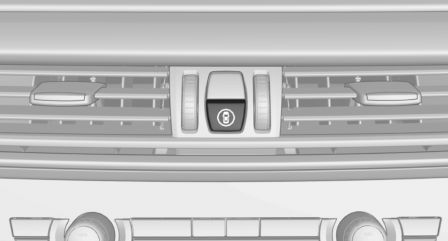
 Intelligent Safety button
Intelligent Safety button
Switching on/off
Some Intelligent Safety systems are automatically active after every departure. Some Intelligent Safety systems activate according to the last setting.
 Press button briefly:
Press button briefly:
- The menu for the intelligent safety system is displayed. The systems are individually switched off according to their respective settings.
- LED lights up orange or goes out respective to their individual settings.
Adjust as needed. Individual settings are stored for the profile currently in use.
 Press button again:
Press button again:
- All Intelligent Safety systems are activated.
- The LED lights up green.
 Hold down button:
Hold down button:
- All Intelligent Safety systems are turned off.
- The LED goes out.
Front-end collision warning
Depending on the equipment, the collision warning system consists of one of the two systems:
- Front-end collision warning with City Braking function
- Front-end collision warning with braking function
Front-end collision warning with City Braking function
The concept
The ystem can help prevent accidents. If an accident cannot be prevented, the system will help reduce the collision speed.
The system sounds a warning before an imminent collision and actuates brakes independently if needed.
The automatic braking intervention is done with limited force and duration.
A camera in the area of the rearview mirror controls the system.
The front-end collision warning is available even if cruise control has been deactivated.
With the vehicle approaching another vehicle intentionally the collision warning is delayed avoiding false alarm.
General information
The system warns at two levels of an imminent danger of collision at speeds from approx.
3 mph/5 km/h. Time of warnings may vary with the current driving situation.
Appropriate braking kicks in at speeds of up to 35 mph/60 km/h.
Detection range
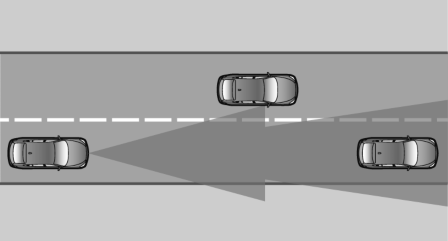
It responds to objects if they are detected by the system.
Hints
Personal responsibility
The system does not serve as a substitute for the driver's personal judgment of the traffic situation.
Be aware of the traffic situation and the vehicle's surroundings at all times, otherwise accidents are still possible despite all warnings.
Adapting your speed and driving style
The displays and warnings of the system do not relieve the driver of the responsibility to adapt his or her driving speed and style to the traffic conditions.
Be alert
Due to system limitations, warnings may be not issued at all, or may be issued late or improperly. Therefore, always be alert and ready to intervene; otherwise, there is the risk of an accident.
Tow-starting and towing
For tow-starting or towing, switch off the Intelligent Safety systems; otherwise malfunctions of the individual braking systems might lead to accidents.
At a glance
Button in the vehicle
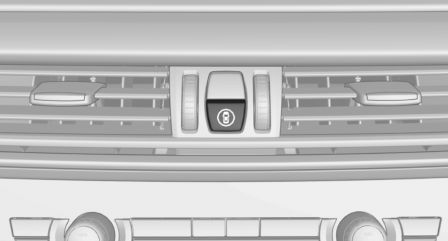
 Intelligent Safety button
Intelligent Safety button
Camera
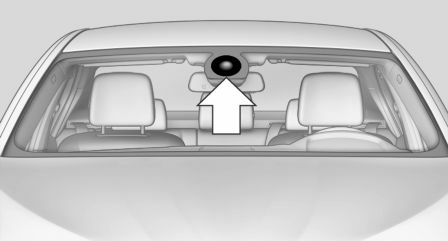
The camera is found near the interior rearview mirror.
Keep the windshield in the area behind the interior rearview mirror clean and clear.
Switching on/off
Switching on automatically The system is automatically active after every driving-off.
Switching on/off manually
 Press button briefly:
Press button briefly:
- The menu for the intelligent safety system is displayed. The systems are individually switched off according to their respective settings.
- LED lights up orange or goes out respective to their individual settings.
Adjust as needed. Individual settings are stored for the profile currently in use.
 Press button again:
Press button again:
- All Intelligent Safety systems are activated.
- The LED lights up green.
 Hold down button:
Hold down button:
- All Intelligent Safety systems are turned off.
- The LED goes out.
Setting the warning time The warning time can be set via iDrive.
1. "Settings"
2. "Frontal Coll. Warning"
3. Activate the desired time on the Control Display.
The selected time is stored for the profile currently in use.
Warning with braking function
Display If a collision with a recognized vehicle is imminent a warning symbol appears in the instrument cluster and in the Head-Up Display.
 The vehicle lights up red:
prewarning.
The vehicle lights up red:
prewarning.
Brake and increase distance.
 The vehicle flashes red and an
acoustic signal sounds: acute warning.
The vehicle flashes red and an
acoustic signal sounds: acute warning.
You are requested to intervene by braking or make an evasive maneuver.
Prewarning This warning is issued, e.g., when there is the impending danger of a collision or the distance to the vehicle ahead is too small.
The driver must intervene actively when there is a prewarning.
Acute warning with braking function Warning of the imminent danger of a collision when the vehicle approaches another object at a relatively high differential speed.
The driver must intervene actively when there is an acute warning. If necessary, the driver is assisted by a minor automatic braking intervention in a possible risk of collision.
Acute warnings can also be triggered without previous prewarning.
Braking intervention The warning prompts the driver himself/herself to react. During a warning, the maximum braking force is used. Premise for the brake booster is sufficiently quick and hard stepping on the brake pedal. The system can assist with some braking intervention if there is risk of a collision. At low speeds vehicles may thus come to a complete stop.
The braking intervention is executed only if DSC Dynamic Stability Control is switched on and Dynamic Traction Control DTC is activated.
The braking intervention can be interrupted by stepping on the accelerator pedal or by actively moving the steering wheel.
Object detection can be restricted. Limitations of the detection range and functional restrictions are to be considered.
System limits
Detection range The system's detection potential is limited.
Thus a warning might not be issued or be issued late.
E. g. the following situations may not be detected:
- Slow moving vehicles when you approach them at high speed.
- Vehicles that suddenly swerve in front of you, or sharply decelerating vehicles.
- Vehicles with an unusual rear appearance.
- Two-wheeled vehicles ahead of you.
Functional limitations The system may not be fully functional in the following situations:
- In heavy fog, rain, sprayed water or snowfall.
- In tight curves.
- If the driving stability control systems are limited or deactivated, e.g., DSC OFF.
- If, depending on the vehicle equipment version, the field of view of the camera in the mirror or the radar sensor is dirty or obscured.
- Up to 10 seconds after the start of the engine, via the Start/Stop knob.
- During calibration of the camera immediately after vehicle shipment.
- If there is constant blinding effects because of oncoming light, e. g., from the sun low in the sky.
Warning sensitivity The more sensitive the warning settings are, e.g. the warning time, the more warnings are displayed. However, there may also be an excess of false warnings.
Front-end collision warning with braking function
The concept
The ystem can help prevent accidents. If an accident cannot be prevented, the system will help reduce the collision speed.
The system sounds a warning before an imminent collision and actuates brakes independently if needed.
The automatic braking intervention may be executed with maximum braking force and for a brief period only as necessary.
If the vehicle is equipped with Active Cruise Control with Stop & Go, the front-end collision warning is controlled via the cruise control radar sensor in conjunction with a camera.
The front-end collision warning is available even if cruise control has been deactivated.
With the vehicle approaching another vehicle intentionally the collision warning is delayed avoiding false alarm.
General information
The system issues a two-phase warning of a possible danger of collision with vehicles at speeds above approx. 3 mph/5 km/h. Time of warnings may vary with the current driving situation.
Detection range
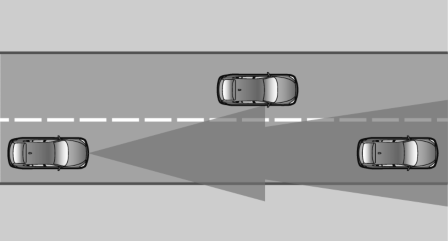
It responds to objects if they are detected by the system.
Hints
Personal responsibility
The system does not serve as a substitute for the driver's personal judgment of the traffic situation.
Be aware of the traffic situation and the vehicle's surroundings at all times, otherwise accidents are still possible despite all warnings.
Adapting your speed and driving style
The displays and warnings of the system do not relieve the driver of the responsibility to adapt his or her driving speed and style to the traffic conditions.
Be alert
Due to system limitations, warnings may be not issued at all, or may be issued late or improperly. Therefore, always be alert and ready to intervene; otherwise, there is the risk of an accident.
Tow-starting and towing
For tow-starting or towing, switch off the Intelligent Safety systems; otherwise malfunctions of the individual braking systems might lead to accidents.
At a glance
Button in the vehicle
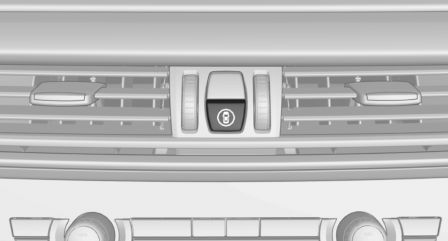
 Intelligent Safety button
Intelligent Safety button
Radar sensor
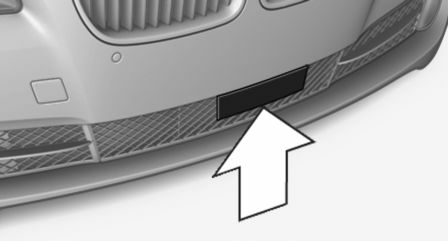
The radar sensor is located in the lower area of the front bumper.
Always keep radar sensor clean and unobstructed.
Camera
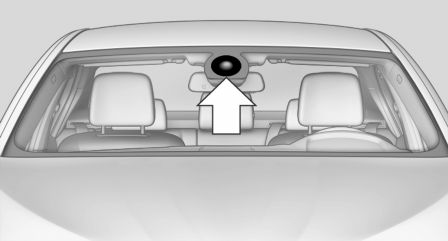
The camera is found near the interior rearview mirror.
Keep the windshield in the area behind the interior rearview mirror clean and clear.
Switching on/off
Switching on automatically The system is automatically active after every driving-off.
Switching on/off manually
 Press button briefly:
Press button briefly:
- The menu for the intelligent safety system is displayed. The systems are individually switched off according to their respective settings.
- LED lights up orange or goes out respective to their individual settings.
Adjust as needed. Individual settings are stored for the profile currently in use.
 Press button again:
Press button again:
- All Intelligent Safety systems are activated.
- The LED lights up green.
 Hold down button:
Hold down button:
- All Intelligent Safety systems are turned off.
- The LED goes out.
Setting the warning time
The warning time can be set via iDrive.
1. "Settings"
2. "Frontal Coll. Warning"
3. Activate the desired time on the Control Display.
The selected time is stored for the profile currently in use.
Warning with braking function
Display If a collision with a recognized vehicle is imminent a warning symbol appears in the instrument cluster and in the Head-Up Display.
 The vehicle lights up red:
prewarning.
The vehicle lights up red:
prewarning.
Brake and increase distance.
 The vehicle flashes red and an
acoustic signal sounds: acute warning.
The vehicle flashes red and an
acoustic signal sounds: acute warning.
You are requested to intervene by braking or make an evasive maneuver.
Prewarning This warning is issued, e.g., when there is the impending danger of a collision or the distance to the vehicle ahead is too small.
The driver must intervene actively when there is a prewarning.
Acute warning with braking function Warning of the imminent danger of a collision when the vehicle approaches another object at a relatively high differential speed.
The driver must intervene actively when there is an acute warning. If necessary, the driver is assisted by an automatic braking intervention in a possible risk of collision.
Acute warnings can also be triggered without previous prewarning.
Braking intervention The warning prompts the driver himself/herself to react. During a warning, the maximum braking force is used. Premise for the brake booster is sufficiently quick and hard stepping on the brake pedal. The system can assist with automatic braking intervention if there is risk of a collision. The intervention can bring the vehicle to a complete stop.
The braking intervention is executed only if DSC Dynamic Stability Control is switched on and Dynamic Traction Control DTC is activated.
Above approx. 130 mph/210 km/h the braking intervention occurs as a brief braking pressure.
No automatic delay occurs.
The braking intervention can be interrupted by stepping on the accelerator pedal or by actively moving the steering wheel.
Object detection can be restricted. Limitations of the detection range and functional restrictions are to be considered.
System limits
Detection range The system's detection potential is limited.
Thus a warning might not be issued or be issued late.
E. g. the following situations may not be detected:
- Slow moving vehicles when you approach them at high speed.
- Vehicles that suddenly swerve in front of you, or sharply decelerating vehicles.
- Vehicles with an unusual rear appearance.
- Two-wheeled vehicles ahead of you.
Functional limitations The system may not be fully functional in the following situations:
- In heavy fog, rain, sprayed water or snowfall.
- In tight curves.
- If the driving stability control systems are limited or deactivated, e.g., DSC OFF.
- If, depending on the vehicle equipment version, the field of view of the camera in the mirror or the radar sensor is dirty or obscured.
- Up to 10 seconds after the start of the engine, via the Start/Stop knob.
- During calibration of the camera immediately after vehicle shipment.
- If there is constant blinding effects because of oncoming light, e. g., from the sun low in the sky.
Warning sensitivity The more sensitive the warning settings are, e.g. the warning time, the more warnings are displayed. However, there may also be an excess of false warnings.
Pedestrian warning with city braking function
The concept
The ystem can help prevent accidents with pedestrians.
The system issues a warning in the city driving speed area if there is imminent danger of a collision with pedestrians and includes a braking function.
The camera in the area of the rearview mirror controls the system.
General information
In daylight the system warns of possible collisions with pedestrians at speeds from about 6 mph/10 km/h to about 35 mph/60 km/h shortly before a collision the system supports you with a braking intervention.
Under those circumstances it reacts to people who are within the detection range of the system.
Detection range
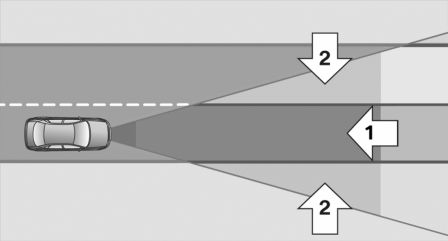
The detection area in front of the vehicle is divided into two areas.
- Central area, arrow 1, directly in front of the vehicle.
- Expanded area, arrow 2, to the right and left.
A collision is imminent if pedestrians are located within the central area. A warning is issued about pedestrians who are located within the extended area only if they are moving in the direction of the central area.
Hints
Personal responsibility
The system does not serve as a substitute for the driver's personal judgment of the traffic situation.
Be aware of the traffic situation and the vehicle's surroundings at all times, otherwise accidents are still possible despite all warnings.
Adapting your speed and driving style
The displays and warnings of the system do not relieve the driver of the responsibility to adapt his or her driving speed and style to the traffic conditions.
Be alert
Due to system limitations, warnings may be not issued at all, or may be issued late or improperly. Therefore, always be alert and ready to intervene; otherwise, there is the risk of an accident.
Tow-starting and towing
For tow-starting or towing, switch off the Intelligent Safety systems; otherwise malfunctions of the individual braking systems might lead to accidents.
At a glance
Button in the vehicle
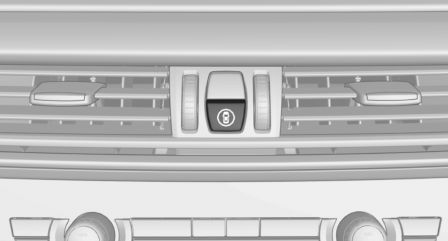
 Intelligent Safety button
Intelligent Safety button
Camera
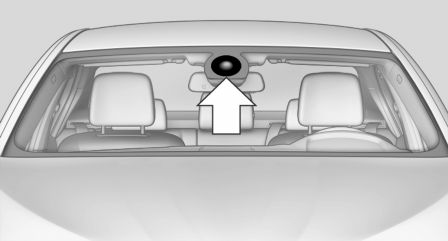
The camera is found near the interior rearview mirror.
Keep the windshield in the area behind the interior rearview mirror clean and clear.
Switching on/off
Switching on automatically The system is automatically active after every driving-off.
Switching on/off manually
 Press button briefly:
Press button briefly:
- The menu for the intelligent safety system is displayed. The systems are individually switched off according to their respective settings.
- LED lights up orange or goes out respective to their individual settings.
Adjust as needed. Individual settings are stored for the profile currently in use.
 Press button again:
Press button again:
- All Intelligent Safety systems are activated.
- The LED lights up green.
 Hold down button:
Hold down button:
- All Intelligent Safety systems are turned off.
- The LED goes out.
Warning with braking function
Display If a collision with a person detected in this way is imminent, a warning symbol appears on the instrument cluster and in the Head-up Display.
 The red symbol is displayed and
a signal
sounds.
The red symbol is displayed and
a signal
sounds.
Intervene immediately by braking or make an evasive maneuver.
Braking intervention The warning prompts the driver himself/herself to react. During a warning, the maximum braking force is used. Premise for the brake booster is sufficiently quick and hard stepping on the brake pedal. The system can assist with some braking intervention if there is risk of a collision. At low speeds vehicles may thus come to a complete stop.
The braking intervention is executed only if DSC Dynamic Stability Control is switched on and Dynamic Traction Control DTC is activated.
The braking intervention can be interrupted by stepping on the accelerator pedal or by actively moving the steering wheel.
Object detection can be restricted. Limitations of the detection range and functional restrictions are to be considered.
System limits
Detection range The detection potential of the camera is limited.
Thus a warning might not be issued or be issued late.
E. g. the following situations may not be detected:
- Partially covered pedestrians.
- Pedestrians that are not detected as such because of the viewing angle or contour.
- Pedestrians outside of the detection range.
- Pedestrians having a body size less than 32 in/80 cm.
Functional limitations The system may not be fully functional or may not be available in the following situations:
- In heavy fog, rain, sprayed water or snowfall.
- In tight curves.
- If the driving stability control systems are deactivated, e.g. DSC OFF.
- If the camera viewing field or the front windshield are dirty or covered.
- Up to 10 seconds after the start of the engine, via the Start/Stop knob.
- During calibration of the camera immediately after vehicle shipment.
- If there is constant blinding effects because of oncoming light, e. g., from the sun low in the sky.
- When it is dark outside.
Lane departure warning
The concept
Starting at a specific speed, this system alerts you when the vehicle on streets with lane markings is about to leave the lane. This speed, depending on the country version, is between 35 mph/55 km/h and 45 mph/70 km/h.
The steering wheel begins vibrating gently in the event of warnings. The time of the warning may vary depending on the current driving situation.
The system does not provide a warning if the turn signal is set before leaving the lane.
Hints
Personal responsibility
The system cannot serve as a substitute for the driver's personal judgment of the course of the road and the traffic situation.
In the event of a warning, do not jerk the steering wheel, as you may lose control of the vehicle.
At a glance
Button in the vehicle
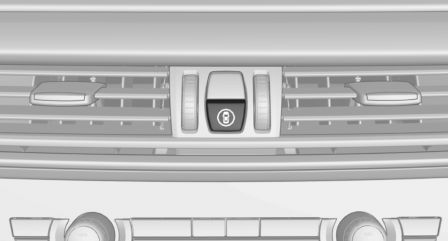
 Intelligent Safety button
Intelligent Safety button
Camera
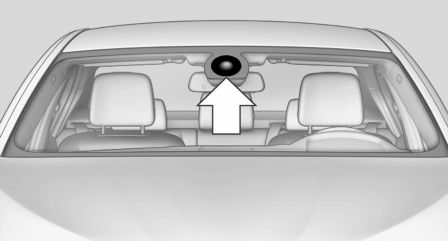
The camera is found near the interior rearview mirror.
Keep the windshield in the area behind the interior rearview mirror clean and clear.
Switching on/off
Switching on automatically The lane departure warning is automatically activated after departure, if the function was switched on the last time the engine was stopped.
Switching on/off manually
 Press button briefly:
Press button briefly:
- The menu for the intelligent safety system is displayed. The systems are individually switched off according to their respective settings.
- LED lights up orange or goes out respective to their individual settings.
Adjust as needed. Individual settings are stored for the profile currently in use.
 Press button again:
Press button again:
- All Intelligent Safety systems are activated.
- The LED lights up green.
 Hold down button:
Hold down button:
- All Intelligent Safety systems are turned off.
- The LED goes out.
Display in the instrument cluster

- Lines: system is activated.
- Arrows: at least one lane marking was detected and warnings can be issued.
Issued warning
If you leave the lane and if a lane marking has been detected, the steering wheel begins vibrating.
If the turn signal is set before changing the lane, a warning is not issued.
End of warning
The warning ends:
- Automatically after approx. 3 seconds.
- When returning to your own lane.
- When braking hard.
- When using the turn signal.
System limits
The system may not be fully functional in the following situations:
- In heavy fog, rain or snowfall.
- In the event of missing, worn, poorly visible, merging, diverging, or multiple lane markings such as in construction areas.
- When lane markings are covered in snow, ice, dirt or water.
- In tight curves or on narrow lanes.
- When the lane markings are covered by objects.
- When driving very close to the vehicle in front of you.
- When driving toward bright lights.
- When the windshield in front of the interior rearview mirror is fogged over, dirty or covered with stickers, etc.
- During calibration of the camera immediately after vehicle shipment.
Active Blind Spot Detection
The concept
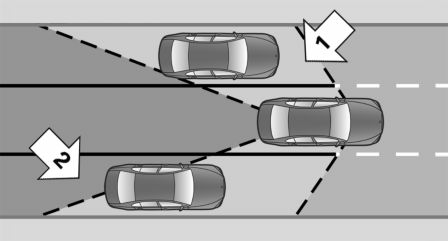
Two radar sensors below the rear bumper monitor the area behind and next to the vehicle at speeds above approx. 30 mph/50 km/h.
The system indicates whether there are vehicles in the blind spot, arrow 1, or approaching from behind on the adjacent lane, arrow 2.
The lamp in the exterior mirror housing is dimmed.
Before you change lanes after setting the turn signal, the system issues a warning in the situations described above.
The lamp in the exterior mirror housing flashes and the steering wheel vibrates.
Hints
Personal responsibility
The system does not serve as a substitute for the driver's personal judgment of the traffic situation.
Be aware of the traffic situation and the vehicle's surroundings at all times, otherwise accidents are still possible despite all warnings.
At a glance
Button in the vehicle
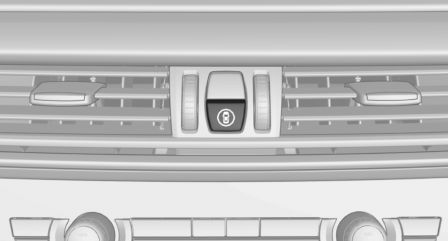
 Intelligent Safety button
Intelligent Safety button
Radar sensors
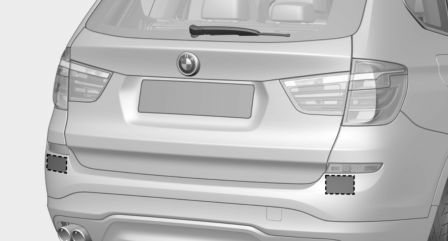
The radar sensors are located under the rear bumper.
Switching on/off
Switching on automatically The Active Blind Spot Detection is automatically activated after departure, if the function was switched on the last time the engine was stopped.
Switching on/off manually
 Press button briefly:
Press button briefly:
- The menu for the intelligent safety system is displayed. The systems are individually switched off according to their respective settings.
- LED lights up orange or goes out respective to their individual settings.
Adjust as needed. Individual settings are stored for the profile currently in use.
 Press button again:
Press button again:
- All Intelligent Safety systems are activated.
- The LED lights up green.
 Hold down button:
Hold down button:
- All Intelligent Safety systems are turned off.
- The LED goes out.
Display
Lamp in the exterior mirror housing
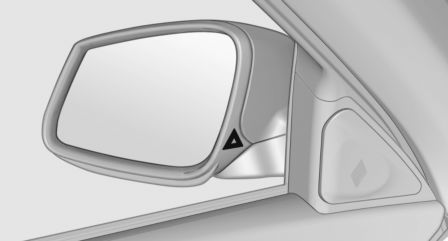
Information stage The dimmed lamp in the exterior mirror housing indicates when there are vehicles in the blind spot or approaching from behind.
Warning If the turn signal is set while a vehicle is in the critical zone, the steering wheel vibrates briefly and the lamp in the exterior mirror housing flashes brightly.
The warning stops when the turn signal is switched off, or the other vehicle leaves the critical zone.
System limits
The system may not be fully functional in the following situations:
- When a vehicle is approaching at a speed much faster than your own.
- In heavy fog, rain or snowfall.
- In tight curves or on narrow lanes.
- If the bumper is dirty or iced up, or covered with stickers.
A Check Control message is displayed when the system is not fully functional.
For US owners only
The transmitter and receiver units comply with part 15 of the FCC/Federal Communication Commission regulations. Operation is governed by the following: FCC ID:
- NBG009014A.
Compliance statement: This device complies with part 15 of the FCC Rules. Operation is subject to the following two conditions:
- This device may not cause harmful interference, and
- this device must accept any interference received, including interference that may cause undesired operation.
Any unauthorized modifications or changes to these devices could void the user's authority to operate this equipment.
Brake force display
The concept
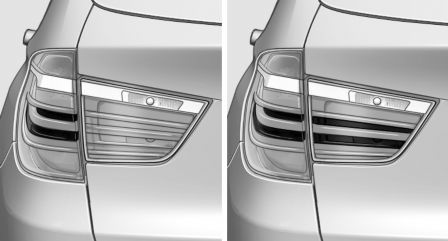
- During normal brake application, the outer brake lights light up.
- During heavy brake application, the inner brake lights light up in addition.
 Lights
Lights
Vehicle features and options
This chapter describes all standard, country-specific
and optional features offered with the
series. It also describes ...
 Driving stability control systems
Driving stability control systems
Vehicle features and options
This chapter describes all standard, country-specific
and optional features offered with the
series. It also describes ...
Other materials:
BMW X3 (F25) Service & Repair Manual > Electrical: Preheating relay
REPLACING PREHEATING CONTROL UNIT (N47D20 O1)
Necessary preliminary tasks:
Switch off ignition.
Remove INTAKE SILENCER HOUSING .
Release positive battery cable (1) from clamp.
Release expanding rivets (2).
Remove rear acoustic cover (3).
Detach connector (1) from preheating contro ...
